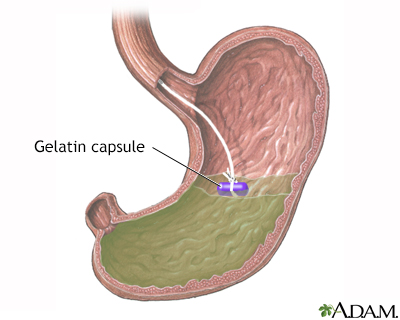String test for intestinal parasites
A string test involves swallowing a string to obtain a sample from the upper part of the small intestine. The sample is then tested to look for intestinal parasites.
How the Test is Performed
To have this test, you swallow a string with a weighted gelatin capsule on the end. The string is pulled out 4 hours later. Any bile, blood, or mucus attached to the string is examined under the microscope. This is done to look for cells and parasites or parasite eggs.
Bile
Bile is a fluid that is made and released by the liver and stored in the gallbladder. Bile helps with digestion. It breaks down fats into fatty acid...

How to Prepare for the Test
You may be asked not to eat or drink anything for 12 hours before the test.
How the Test will Feel
You may find it hard to swallow the string. You may have an urge to vomit when the string is being removed.
Why the Test is Performed
The test is performed when your health care provider suspects that you have a parasite infection. Usually a stool sample is tested first. A string test may be done if the stool sample is negative but a parasite infection is still suspected.
Normal Results
No blood, parasites, fungi, or abnormal cells is normal.
Normal value ranges may vary slightly among different laboratories. Talk to your provider about the meaning of your test results.
What Abnormal Results Mean
Abnormal results may be a sign of parasite infection, such as giardia.
Giardia
Giardia, or giardiasis, is a parasitic infection of the small intestine. A tiny parasite called Giardia lamblia causes it.

Considerations
Treatment with certain medicines can affect the test results.
Other string tests may be used for different conditions.
Reviewed By
Jenifer K. Lehrer, MD, Department of Gastroenterology, Aria - Jefferson Health Torresdale, Jefferson Digestive Diseases Network, Philadelphia, PA. Review provided by VeriMed Healthcare Network. Also reviewed by David C. Dugdale, MD, Medical Director, Brenda Conaway, Editorial Director, and the A.D.A.M. Editorial team.
Adam RD. Giardiasis. In: Ryan ET, Hill DR, Solomon T, Aronson NE, Endy TP, eds. Hunter's Tropical Medicine and Emerging Infectious Diseases. 10th ed. Philadelphia, PA: Elsevier; 2020:chap 95.
Melia JMP, Sears CL. Infectious enteritis and proctocolitis. In: Feldman M, Friedman LS, Brandt LJ, eds. Sleisenger and Fordtran's Gastrointestinal and Liver Disease. 11th ed. Philadelphia, PA: Elsevier; 2021:chap 110.
Siddiqi HA, Rabinowitz S, Axiotis CA.. Laboratory diagnosis of gastrointestinal and pancreatic disorders. In: McPherson RA, Pincus MR, eds. Henry's Clinical Diagnosis and Management by Laboratory Methods. 24th ed. Philadelphia, PA: Elsevier; 2022:chap 23.
Wojewoda CM. Stempak LM. Medical bacteriology. In: McPherson RA, Pincus MR, eds. Henry's Clinical Diagnosis and Management by Laboratory Methods. 24th ed. Philadelphia, PA: Elsevier; 2022:chap 57.


 All rights reserved.
All rights reserved.